Abstract
Acid inhibitory therapy has long been considered of no benefit for upper GI bleeding. The reason was that achlorhydria in the stomach could not be achieved with any single or combination of acid inhibitory drugs. The introduction of proton pump inhibitors has, for the first time, allowed the physician to temporarily achieve achlorhydria by large doses of intravenously applied proton pump inhibitors. The first placebo-controlled clinical trials have shown that, indeed, an intragastric pH of near 7 can significantly improve the clinical outcome of upper GI bleeding. Pharmacokinetic studies with proton pump inhibitors have shown that a bolus of 80 mg pantoprazole or omeprazole followed by immediate continuous infusion of eight mg per hour will result in an intragastric pH of 7 within 20 minutes. This intragastric pH optimizes the different steps of hemostasis in the stomach.
Full text
PDF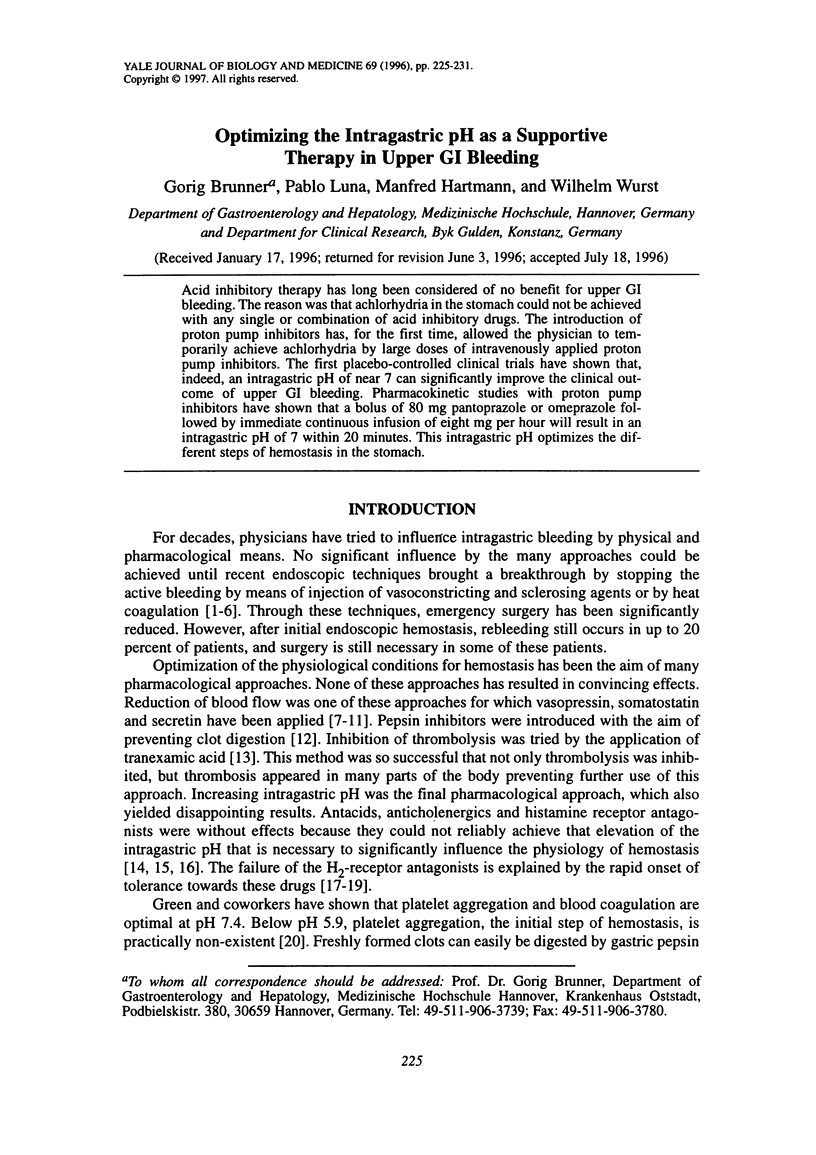
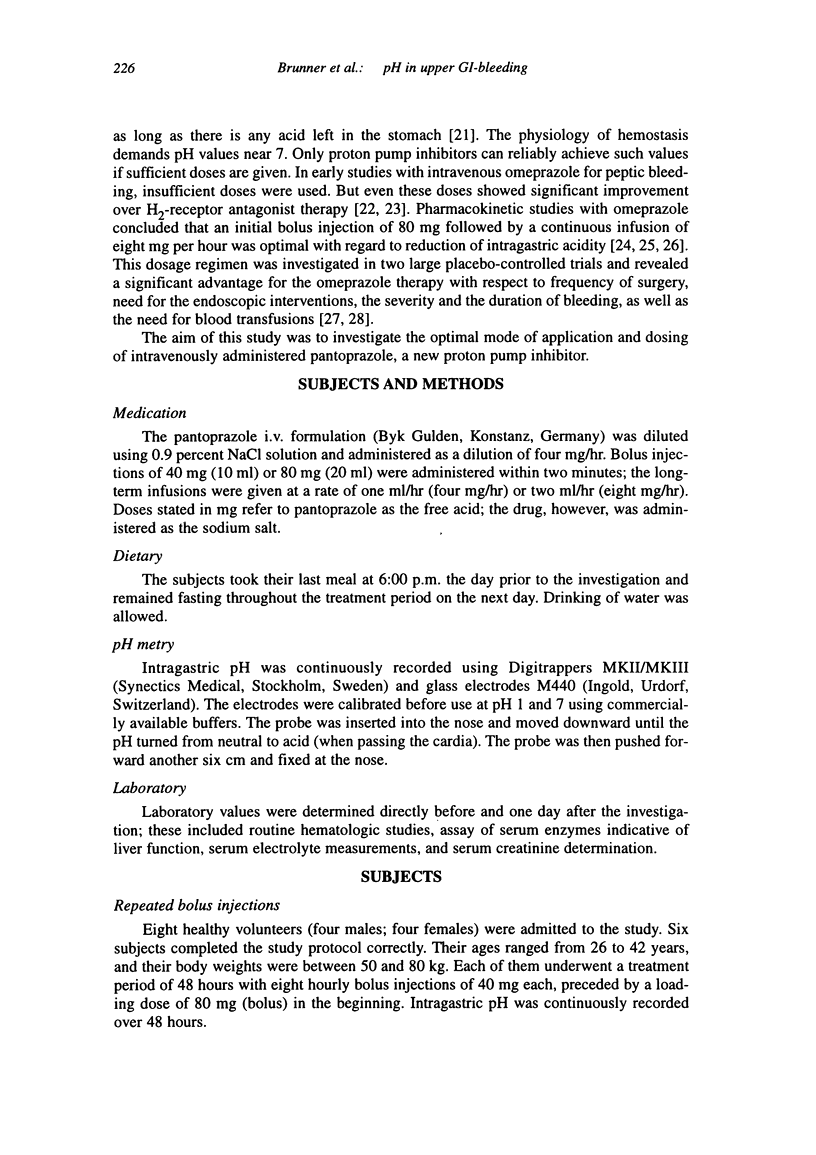
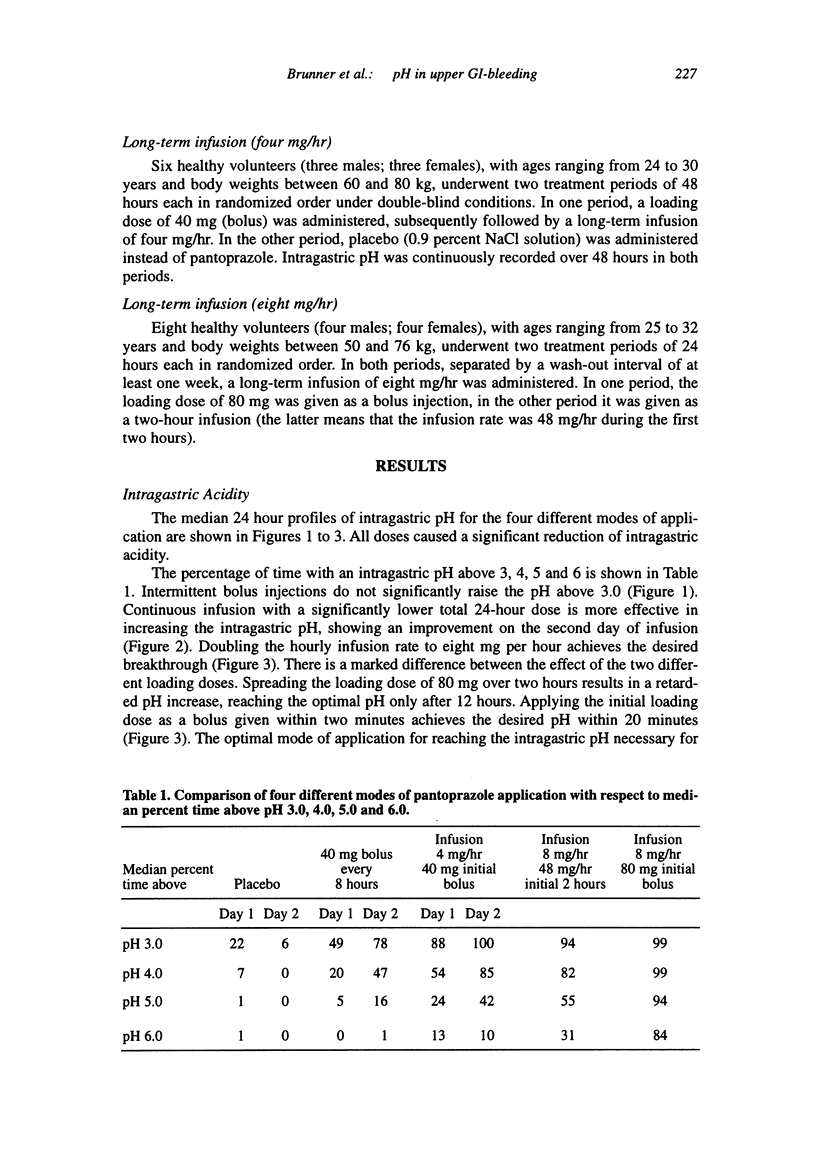
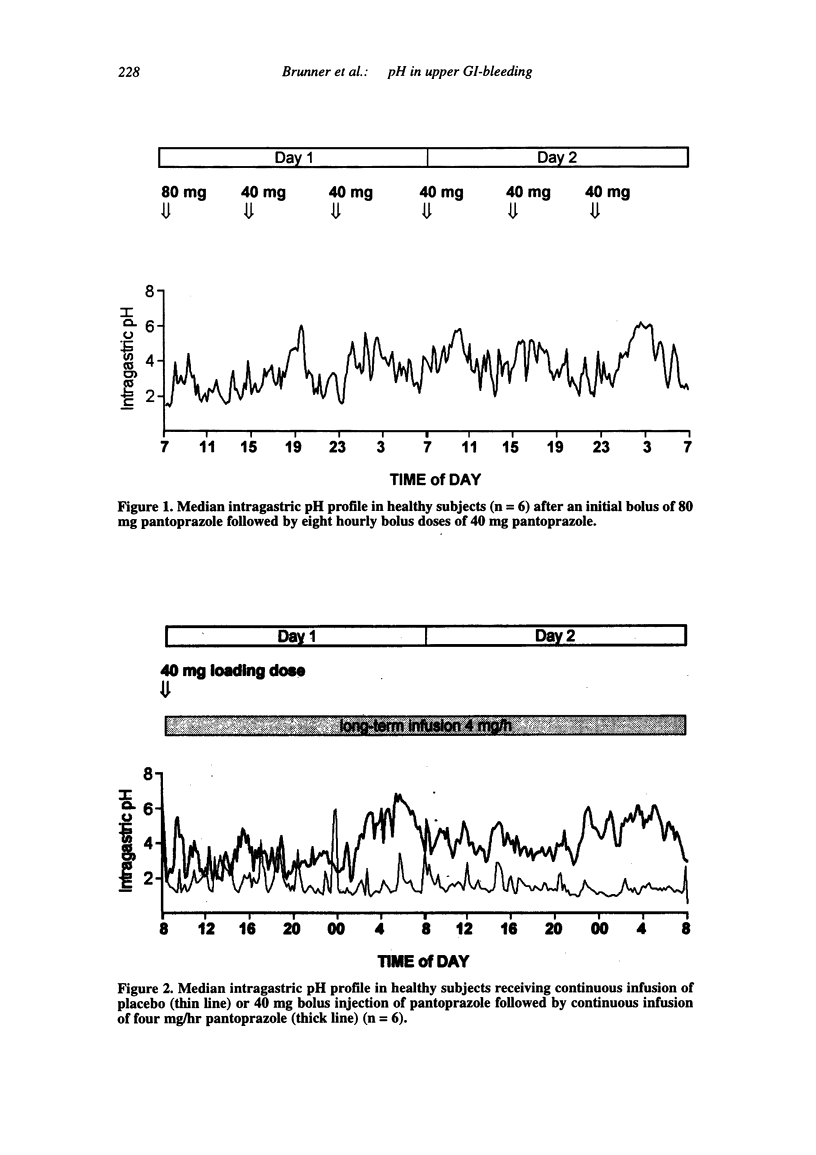
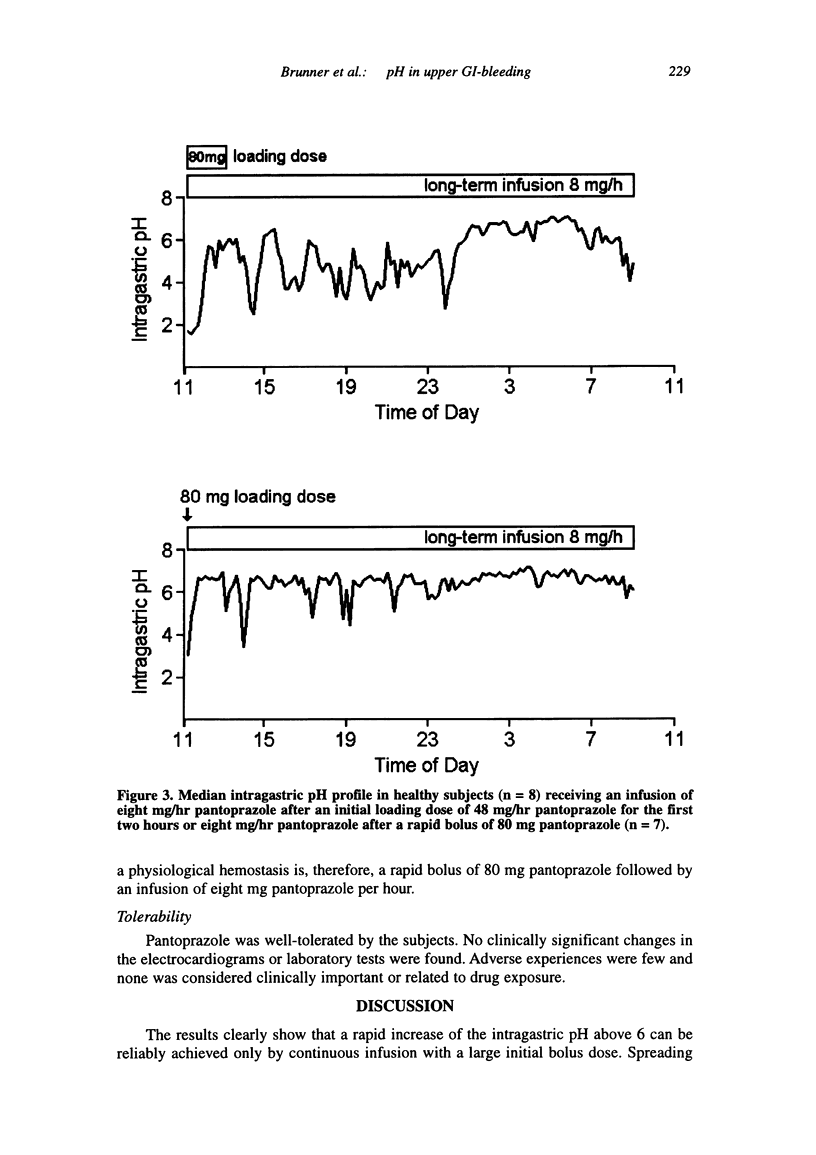
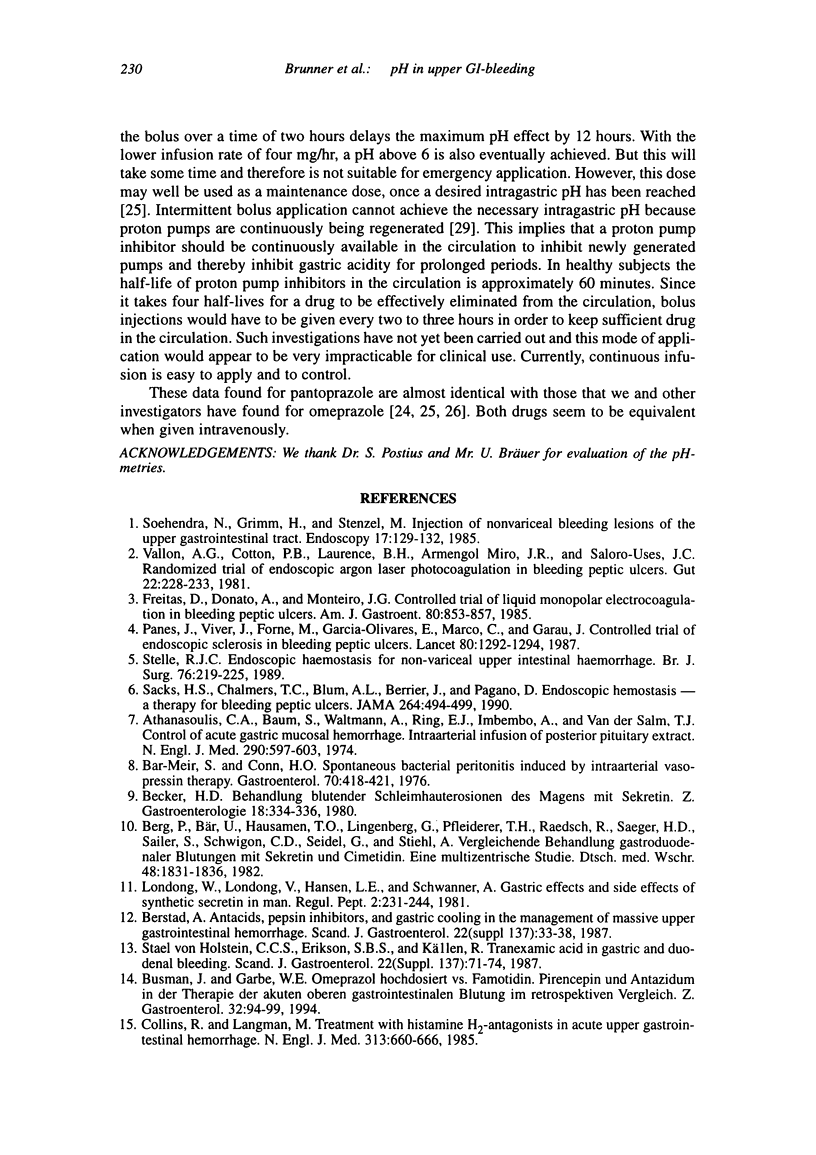
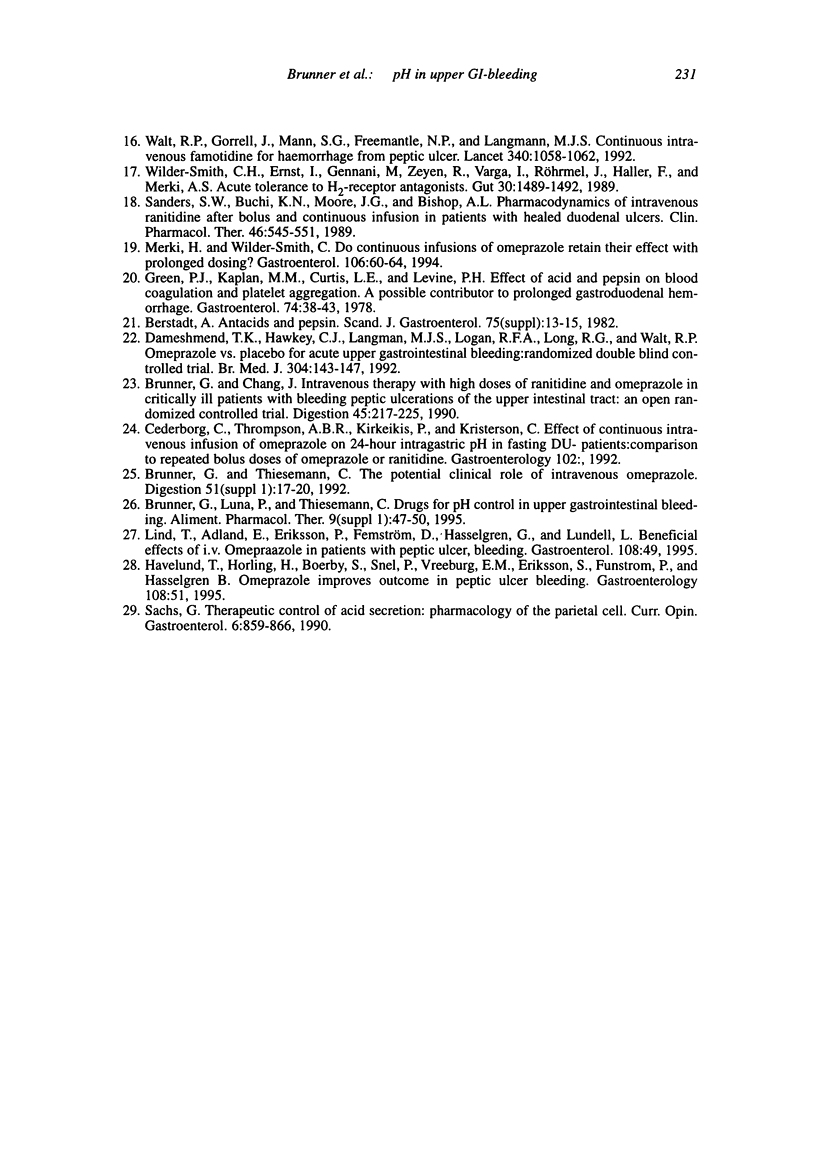
Selected References
These references are in PubMed. This may not be the complete list of references from this article.
- Athanasoulis C. A., Baum S., Waltman A. C., Ring E. J., Imbembo A., Vander Salm T. J. Control of acute gastric mucosal hemorrhage. Intra-arterial infusion of posterior pituitary extract. N Engl J Med. 1974 Mar 14;290(11):597–603. doi: 10.1056/NEJM197403142901105. [DOI] [PubMed] [Google Scholar]
- Bar-Meir S., Conn H. O. Spontaneous bacterial peritonitis induced by intraarterial vasopressin therapy. Gastroenterology. 1976 Mar;70(3):418–421. [PubMed] [Google Scholar]
- Becker H. D. Behandlung blutender Schleimhauterosionen des Magens mit Sekretin. Z Gastroenterol. 1980 Jun;18(6):334–336. [PubMed] [Google Scholar]
- Berg P., Bär U., Hausamen T. U., Lingenberg G., Pfleiderer T., Raedsch R., Saeger H. D., Sailer S., Schwigon C. D., Seidel G. Vergleichende Behandlung gastroduodenaler Blutungen mit Sekretin und Cimetidin. Eine multizentrische Studie. Dtsch Med Wochenschr. 1982 Dec 3;107(48):1831–1836. doi: 10.1055/s-2008-1070216. [DOI] [PubMed] [Google Scholar]
- Berstad A. Antacids, pepsin inhibitors, and gastric cooling in the management of massive upper gastrointestinal haemorrhage. Scand J Gastroenterol Suppl. 1987;137:33–38. doi: 10.3109/00365528709089759. [DOI] [PubMed] [Google Scholar]
- Brunner G. H., Thiesemann C. The potential clinical role of intravenous omeprazole. Digestion. 1992;51 (Suppl 1):17–20. doi: 10.1159/000200909. [DOI] [PubMed] [Google Scholar]
- Brunner G., Chang J. Intravenous therapy with high doses of ranitidine and omeprazole in critically ill patients with bleeding peptic ulcerations of the upper intestinal tract: an open randomized controlled trial. Digestion. 1990;45(4):217–225. doi: 10.1159/000200249. [DOI] [PubMed] [Google Scholar]
- Brunner G., Luna P., Thiesemann C. Drugs for pH control in upper gastrointestinal bleeding. Aliment Pharmacol Ther. 1995;9 (Suppl 1):47–50. doi: 10.1111/j.1365-2036.1995.tb00784.x. [DOI] [PubMed] [Google Scholar]
- Busam J., Garbe W. E. Omeprazol hochdosiert versus Famotidin, Pirenzepin und Antazidum in der Therapie der akuten oberen gastrointestinalen Blutung im retrospektiven Vergleich. Z Gastroenterol. 1994 Feb;32(2):94–99. [PubMed] [Google Scholar]
- Collins R., Langman M. Treatment with histamine H2 antagonists in acute upper gastrointestinal hemorrhage. Implications of randomized trials. N Engl J Med. 1985 Sep 12;313(11):660–666. doi: 10.1056/NEJM198509123131104. [DOI] [PubMed] [Google Scholar]
- Daneshmend T. K., Hawkey C. J., Langman M. J., Logan R. F., Long R. G., Walt R. P. Omeprazole versus placebo for acute upper gastrointestinal bleeding: randomised double blind controlled trial. BMJ. 1992 Jan 18;304(6820):143–147. doi: 10.1136/bmj.304.6820.143. [DOI] [PMC free article] [PubMed] [Google Scholar]
- Freitas D., Donato A., Monteiro J. G. Controlled trial of liquid monopolar electrocoagulation in bleeding peptic ulcers. Am J Gastroenterol. 1985 Nov;80(11):853–857. [PubMed] [Google Scholar]
- Green F. W., Jr, Kaplan M. M., Curtis L. E., Levine P. H. Effect of acid and pepsin on blood coagulation and platelet aggregation. A possible contributor prolonged gastroduodenal mucosal hemorrhage. Gastroenterology. 1978 Jan;74(1):38–43. [PubMed] [Google Scholar]
- Londong W., Londong V., Hanssen L. E., Schwanner A. Gastric effects and side effects of synthetic secretin in man. Regul Pept. 1981 Aug;2(4):231–244. doi: 10.1016/0167-0115(81)90027-6. [DOI] [PubMed] [Google Scholar]
- Merki H. S., Wilder-Smith C. H. Do continuous infusions of omeprazole and ranitidine retain their effect with prolonged dosing? Gastroenterology. 1994 Jan;106(1):60–64. doi: 10.1016/s0016-5085(94)94341-9. [DOI] [PubMed] [Google Scholar]
- Okabe H., Chijiiwa Y., Nakamura K., Yoshinaga M., Akiho H., Harada N., Nawata H. Two endothelin receptors (ETA and ETB) expressed on circular smooth muscle cells of guinea pig cecum. Gastroenterology. 1995 Jan;108(1):51–57. doi: 10.1016/0016-5085(95)90007-1. [DOI] [PubMed] [Google Scholar]
- Panés J., Viver J., Forné M., Garcia-Olivares E., Marco C., Garau J. Controlled trial of endoscopic sclerosis in bleeding peptic ulcers. Lancet. 1987 Dec 5;2(8571):1292–1294. doi: 10.1016/s0140-6736(87)91191-3. [DOI] [PubMed] [Google Scholar]
- Sacks H. S., Chalmers T. C., Blum A. L., Berrier J., Pagano D. Endoscopic hemostasis. An effective therapy for bleeding peptic ulcers. JAMA. 1990 Jul 25;264(4):494–499. doi: 10.1001/jama.264.4.494. [DOI] [PubMed] [Google Scholar]
- Sanders S. W., Buchi K. N., Moore J. G., Bishop A. L. Pharmacodynamics of intravenous ranitidine after bolus and continuous infusion in patients with healed duodenal ulcers. Clin Pharmacol Ther. 1989 Nov;46(5):545–551. doi: 10.1038/clpt.1989.184. [DOI] [PubMed] [Google Scholar]
- Soehendra N., Grimm H., Stenzel M. Injection of nonvariceal bleeding lesions of the upper gastrointestinal tract. Endoscopy. 1985 Jul;17(4):129–132. doi: 10.1055/s-2007-1018481. [DOI] [PubMed] [Google Scholar]
- Steele R. J. Endoscopic haemostasis for non-variceal upper gastrointestinal haemorrhage. Br J Surg. 1989 Mar;76(3):219–225. doi: 10.1002/bjs.1800760305. [DOI] [PubMed] [Google Scholar]
- Vallon A. G., Cotton P. B., Laurence B. H., Armengol Miro J. R., Salord Oses J. C. Randomised trial of endoscopic argon laser photocoagulation in bleeding peptic ulcers. Gut. 1981 Mar;22(3):228–233. doi: 10.1136/gut.22.3.228. [DOI] [PMC free article] [PubMed] [Google Scholar]
- Walt R. P., Cottrell J., Mann S. G., Freemantle N. P., Langman M. J. Continuous intravenous famotidine for haemorrhage from peptic ulcer. Lancet. 1992 Oct 31;340(8827):1058–1062. doi: 10.1016/0140-6736(92)93078-2. [DOI] [PubMed] [Google Scholar]
- von Holstein C. C., Eriksson S. B., Källén R. Tranexamic acid in gastric and duodenal bleeding. Scand J Gastroenterol Suppl. 1987;137:71–74. doi: 10.3109/00365528709089767. [DOI] [PubMed] [Google Scholar]


